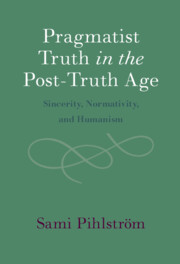Book contents
- Pragmatist Truth in the Post-Truth Age
- Pragmatist Truth in the Post-Truth Age
- Copyright page
- Epigraph
- Contents
- Acknowledgments
- Introduction
- Chapter 1 James’s Children?
- Chapter 2 Religious Truth and Pluralism from a Pragmatist Point of View
- Chapter 3 Around or through Kant?
- Chapter 4 The Will to Believe and Holistic Pragmatism
- Chapter 5 How Is Normativity Possible?
- Chapter 6 Pragmatic Agnosticism – Meaning, Truth, and Suffering
- Conclusion
- References
- Index
Chapter 2 - Religious Truth and Pluralism from a Pragmatist Point of View
Published online by Cambridge University Press: 14 September 2021
- Pragmatist Truth in the Post-Truth Age
- Pragmatist Truth in the Post-Truth Age
- Copyright page
- Epigraph
- Contents
- Acknowledgments
- Introduction
- Chapter 1 James’s Children?
- Chapter 2 Religious Truth and Pluralism from a Pragmatist Point of View
- Chapter 3 Around or through Kant?
- Chapter 4 The Will to Believe and Holistic Pragmatism
- Chapter 5 How Is Normativity Possible?
- Chapter 6 Pragmatic Agnosticism – Meaning, Truth, and Suffering
- Conclusion
- References
- Index
Summary
This chapter continues the discussion of pragmatism and truth from the first chapter by further investigating pluralism about truth in the context of the philosophy of religion, particularly focusing on the debates on religious diversity. Arguing that pragmatism should firmly side with religious inclusivism instead of exclusivism, the chapter compares Jamesian pragmatic pluralism and individualism to Hannah Arendt's more politically framed conception of natality, i.e., human beings' capacity of spontaneously creating novelties into the world, of beginning something anew. This Jamesian-Arendtian entanglement of individuality and novelty can, the chapter proposes, be illuminated by means of holistic pragmatism (indebted to Morton White). The chapter also contains a critical discussion of Naoko Saito's views on what she calls "philosophy as translation" offering a distinctive perspective on pragmatist views on acknowledging diversity, pluralism, and otherness. A defense of Jamesian meliorism, as distinguished from Saito's Cavell-inspired "perfectionism", is also included.
Keywords
- Type
- Chapter
- Information
- Pragmatist Truth in the Post-Truth AgeSincerity, Normativity, and Humanism, pp. 40 - 68Publisher: Cambridge University PressPrint publication year: 2021

